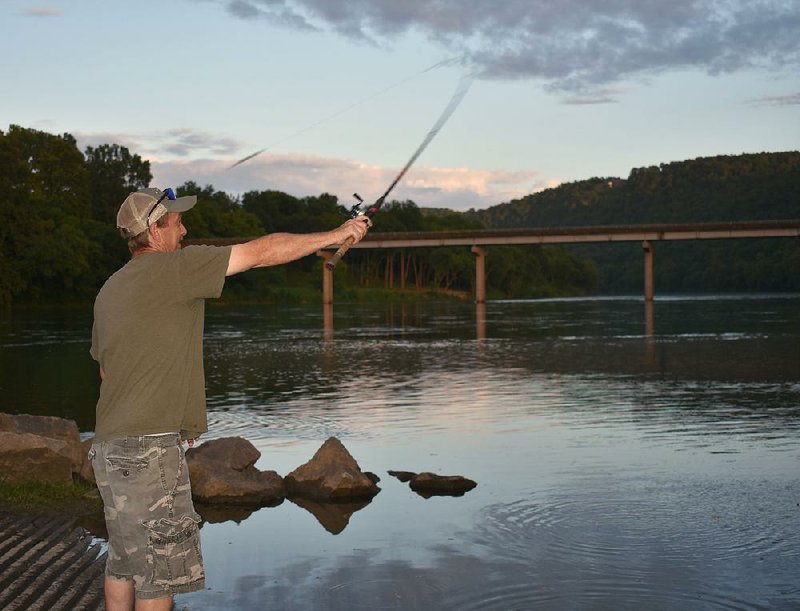MOUNTAIN VIEW -- Ray Tucker and I were down to our last strike in the ninth inning, but a big school of smallmouths triggered a big finish.
The occasion was our annual trout fishing trip on the White River at Mountain View, which high water wrecked for the third consecutive year. Of course, reasonable people would check the hydropower generation schedule at Bull Shoals Dam before traveling, but that's beside the point. In last week's blistering heat, the cold waters of the White River somewhat mitigates the furnace in the sky. It is a comfortable place to be regardless of the fishing conditions.
We launched at the Sylamore Access north of Mountain View. We were happy to see the premises much cleaner than they were on our last visit, but the river was high and fast from the surge of six hydropower generators. However, a receding waterline on the shoreline told us that the water was falling. In three or four hours, it should fall enough for slow drifting.
We made the long ride upriver to Boswell Shoal, where we sought refuge in a feeder creek across the river for lunch. You can sometimes find smallmouth bass in these tributaries, which extend a short distance to the fall line where the stream starts climbing the mountainside.
I left the boat and walked to a bridge support where I saw a small school of Kentucky bass hovering over a rock ledge. My rig was a 5-foot, 6-inch Gander Mountain Creekside rod and a Mitchell Avocet reel spooled with 6-pound test Sufix line. I caught a tiny Kentucky and a tiny smallmouth with a Zoom Tiny Lizard from beneath the ledge, but then I noticed two fish that were considerably bigger on top of the ledge.
With a sidearm cast, I flung the Lizard to the ledge and closed the bail. The bigger fish swam to the lizard, and the line went taut. I set the hook and discovered that the fish was bigger than it looked. It thrashed on the surface and then stripped line from a wailing drag.
That fish had nowhere to go, so I should have been patient. Instead, I tightened the drag three clicks, a fatal error. The fish, which looked to be close to 3 pounds, made one hard surge and snapped my line. We didn't get another bite.
We hoped the White River would fall enough to allow us to fish for smallmouths from Boswell Shoal to the Mount Olive Access. To our dismay, the river came back up.
Anglers have been catching big brown trout in high water on the White by drifting live river minnows. We didn't have the right gear or bait for that, so we cast topwater plugs and jerkbaits near the bank. The only encouragement came from a big smallmouth that knocked my topwater about 3 feet in the air. The fish jumped equally high right beside the bait, but its aim must have been off in the swift current.
With the day getting old, Tucker suggested that we try to salvage the day catching smallmouths in Sylamore Creek.
It took a lot less time to motor back down there than it did to motor up to Boswell, but our prospects of success dimmed further. The creek, which has been unable to drain because of high water on the White River, was bright green, warm and still. Fish wouldn't bite anything we threw.
Moreover, it was exceedingly hot, humid and sticky in the stifling air of the hollow. Sweat poured down our necks, and our shirts were sodden.
Finally, Tucker said, "Two more casts, and let's get out of here."
"Amen to that, brother," I said.
"This is one of the worst days of fishing we've ever had together," Tucker said. We have phenomenally good luck together, and a bad day is unusual.
Mentally, we had already checked out. I began organizing gear so we could more easily transfer it to the truck when we returned to the ramp.
One cast. Nothing.
We were down to our last cast when Tucker, who sat high in a pedestal seat, noticed a big school of fish pass in front of us. He exclaimed that some were large.
I expected to see northern redhorse, which often school in great numbers in Ozark streams. I did a double-take when I saw what appeared to be smallmouth bass. Indeed they were, and in greater numbers than I have ever seen. They appeared to be in three separate schools, each numbering 30-50 fish.
I tossed a topwater lure beyond the visible fish, and a big one smashed the lure. It weighed about 2 pounds, and it lit a fire. We got strikes on every third cast, but hookups were relatively few. Smallmouths hit the lures aggressively, but mostly knocked them sideways. A few took the lure under, but somehow avoided getting hooked.
"Isn't it amazing how a lure with two sets of treble hooks snags every blade of grass, limb or leaf within a yard, but a fish can give it a bear hug and not get a scratch!" I grumbled.
Nevertheless, a topwater strike is exciting enough to keep you casting.
It went on like that for about 90 minutes, but then stopped as the sun faded. Maybe the feeding period was finished, or maybe all that commotion shut down the school.
Either way, they turned our frowns upside down and made for a much more pleasant ride home.
Sports on 06/24/2018
